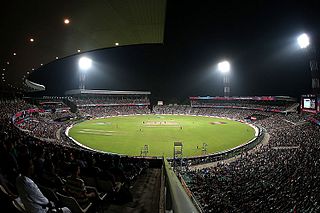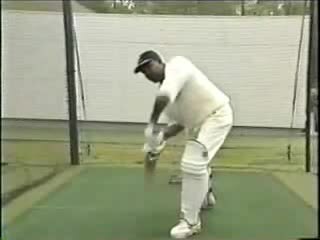The flipper is the name of a particular bowling delivery used in cricket, generally by a leg spin bowler. In essence it is a back spin ball. Squeezed out of the front of the hand with the thumb and first and second fingers, it keeps deceptively low after pitching and can accordingly be very difficult to play. The flipper is comparable to a riseball in fast-pitch softball.

Bowling, in cricket, is the action of propelling the ball toward the wicket defended by a batsman. A player skilled at bowling is called a bowler; a bowler who is also a competent batsman is known as an all-rounder. Bowling the ball is distinguished from throwing the ball by a strictly specified biomechanical definition, which restricts the angle of extension of the elbow. A single act of bowling the ball towards the batsman is called a ball or a delivery. Bowlers bowl deliveries in sets of six, called an over. Once a bowler has bowled an over, a teammate will bowl an over from the other end of the pitch. The Laws of Cricket govern how a ball must be bowled. If a ball is bowled illegally, an umpire will rule it a no-ball. If a ball is bowled too wide of the striker for the batsman to be able to play at it with a proper cricket shot, the bowler's end umpire will rule it a wide.
In cricket, underarm bowling is as old as the sport itself. Until the introduction of the roundarm style in the first half of the 19th century, bowling was performed in the same way as in bowls, the ball being delivered with the hand below the waist. Bowls may well be an older game than cricket and it is possible that cricket was derived from bowls by the intervention of a batsman trying to stop the ball reaching its target by hitting it away, though bowling per se continued as in bowls.

This is a general glossary of the terminology used in the sport of cricket. Where words in a sentence are also defined elsewhere in this article, they appear in italics. Certain aspects of cricket terminology are explained in more detail in cricket statistics and the naming of fielding positions is explained at fielding (cricket).
In the sport of cricket a no-ball is a penalty against the fielding team, usually as a result of an illegal delivery by the bowler. For most cricket games, especially amateur ones, the definition of all forms of no-ball is from the MCC Laws of Cricket
In cricket, a yorker is a ball bowled which hits the cricket pitch around the batsman's feet. When a batsman assumes a normal stance, this generally means that the cricket ball bounces on the cricket pitch on or near the batsman's popping crease. A batsman who advances down the pitch to strike the ball may by so advancing cause the ball to pitch at or around his feet and may thus cause himself to be "yorked".
In the sport of cricket, a bouncer is a type of delivery, usually bowled by a fast bowler.
In the sport of cricket, the crease is a certain area demarcated by white lines painted or chalked on the field of play, and pursuant to the rules of cricket they help determine legal play in different ways for the fielding and batting side. They define the area within which the batsmen and bowlers operate. The term crease may refer to any of the lines themselves, particularly the popping crease, or to the region that they demark. Law 7 of the Laws of Cricket governs the size and position of the crease markings, and defines the actual line as the back edge of the width of the marked line on the grass, i.e., the edge nearest to the wicket at that end.

Fast bowling is one of two main approaches to bowling in the sport of cricket, the other being spin bowling. Practitioners of pace bowling are usually known as fast bowlers, quicks, or pacemen. They can also be referred to as a seam bowler or a 'fast bowler who can swing it' to reflect the predominant characteristic of their deliveries. Strictly speaking, a pure swing bowler does not need to have a high degree of pace, though dedicated medium-pace swing bowlers are rarely seen at Test level these days.
Seam bowling is a bowling technique in cricket whereby the ball is deliberately bowled on to its seam, to cause a random deviation. Practitioners are known as seam bowlers or seamers.
Spin bowling is a bowling technique in cricket and the bowler is referred to as a spinner.
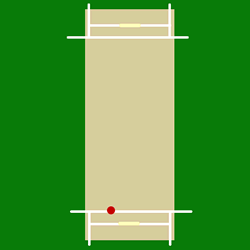
A leg break is a type of delivery in the sport of cricket. It is a delivery of a right-handed leg spin bowler.
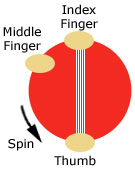
An off cutter is a type of delivery in the game of cricket. It is bowled by fast bowlers.
Law 41 of the Laws of Cricket covers unfair play. This law has developed and expanded over time as various incidents of real life unfair play have been legislated against.

Stumped is a method of dismissal in cricket.
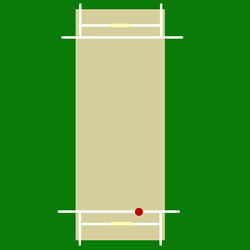
Wrist spin is a type of bowling in the sport of cricket. It refers to the cricket technique and specific hand movements associated with imparting a particular direction of spin to the cricket ball. The other spinning technique, usually used to spin the ball in the opposite direction, is finger spin. Wrist spin is bowled by releasing the ball from the back of the hand, so that it passes over the little finger. Done by a right-handed bowler, this imparts an anticlockwise rotation to the ball, as seen from the bowler's perspective; a left-handed wrist spinner rotates the ball clockwise.
Line and length in cricket refers to the direction and point of bouncing on the pitch of a delivery. The two concepts are frequently discussed together.
Short of a length is a term used in the sport of cricket. It describes a delivery from the bowler that pitches short of the optimum length.



